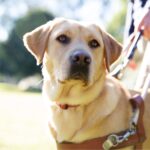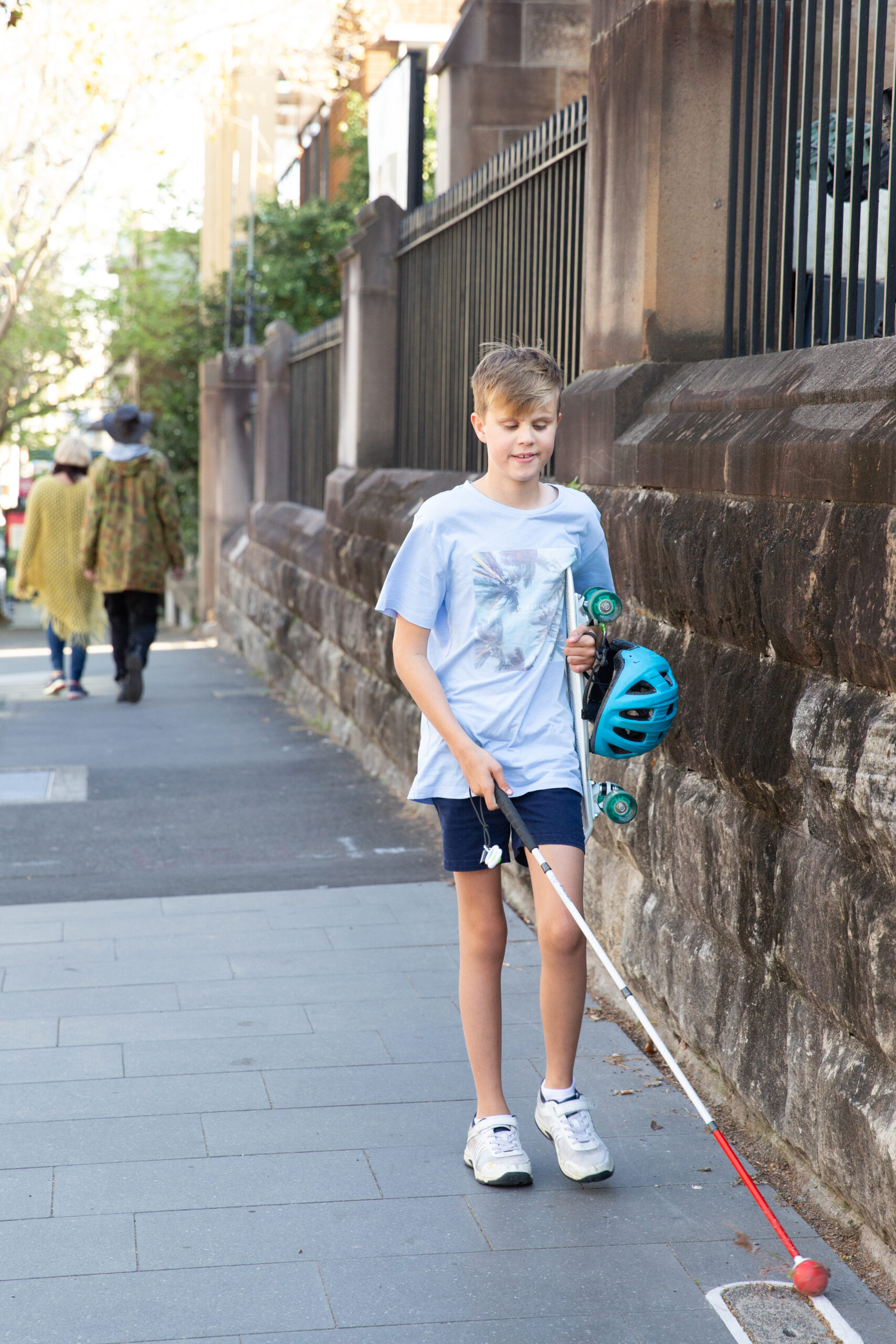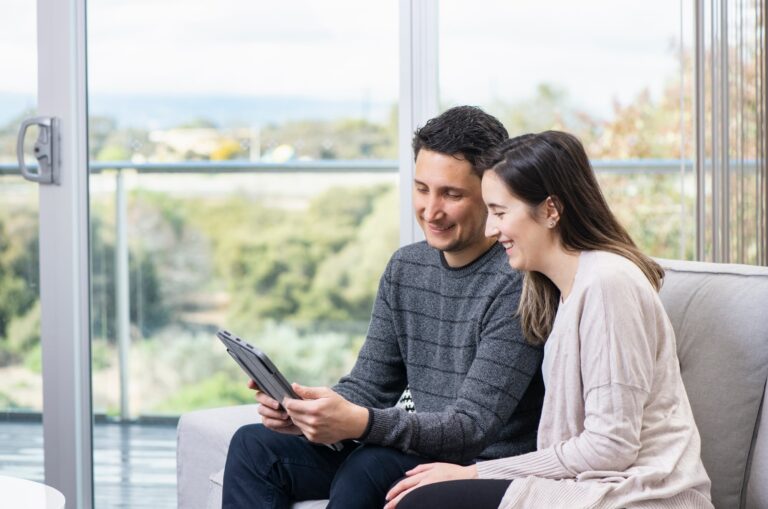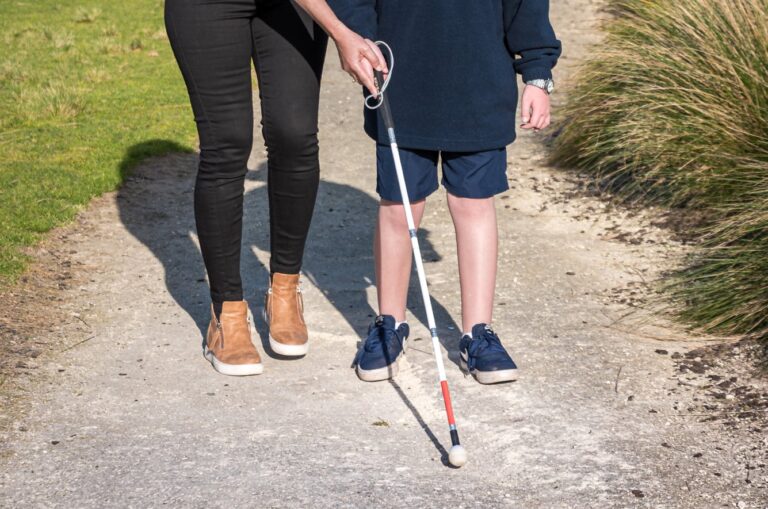Orientation and Mobility Training for different ages
Whatever your age—and whether you’ve experienced low vision or blindness your entire life, or recently had a change in vision—Orientation and Mobility (O&M) training can support you with valuable skills to improve your independence.
All Orientation and Mobility Training programs are uniquely tailored to your personal needs, goals, situation, and preferences.
With that said, there are some common ways that the training can be adapted to meet the requirements of people at different ages. That includes:
- Children.
- Teenagers.
- Adults.
- Older people.
In this article, we’ll describe some of the common skills you can learn in Orientation and Mobility Training, and provide some examples of how training can be modified to meet the needs of people at different stages of life.
Orientation and Mobility training for young children and teenagers.
Orientation and Mobility training for children—which is also commonly called Children’s Mobility training—can adapt to support your child throughout their entire school life, from kindergarten and pre-school through to Year 12 and early adulthood. For children younger than school age, there is a separate support program called Early Childhood Vision Services.
Children’s Mobility training supports young people and children to move through the world with confidence. We know that kids can grow and change quickly, so Children’s Mobility training progressively evolves alongside your child’s needs by introducing different skills and mobility aids as they become relevant in daily life.
Training is usually offered with a specialised Orientation and Mobility instructor. Training sessions complete in a one-on-one format, wherever your child is most comfortable. That might change depending on your child’s goals, but we commonly deliver training:
- In your home.
- At school.
- Out and about in the community.
It’s all about supporting your child to safely explore the world and navigate their daily routine with greater independence.
What kinds of skills can my child learn in Children’s Orientation and Mobility training?
There are many, many different skills that children learn in training. Again, it depends on your child’s personal situation and unique goals. Some common skills include:
- Understanding their place in the world: this can be taught using games and concepts that are already known to your child, like learning spatial concepts by building familiar environments with Lego blocks. The training can also cover using different senses for environmental cues, like the sound of traffic, the smell of a local restaurant on the way home from school, or tactile signals like the texture of the ground changing.
- Learning how to play and move safely: this can include a range of skills at different ages, from learning how to run, jump and skip in younger years to developing cane skills and understanding assistive technologies later on.
Preparing for teenage years: this includes traffic concepts, road safety, and how to independently use public transport to get to school or catch up with friends.
How is the training uniquely tailored for children and young people?
- Early intervention: It can be beneficial to start children’s O&M training as early as possible. This encourages children to develop core foundational skills for independence and mobility as they grow.
- A multi-sensory approach to learning: combining different teaching approaches, based on sound and movement for example, supports children to understand and retain information more effectively.
- Structured, progressive learning activities: we break down O&M skills and concepts into manageable activities that are appropriate for your child’s age, goals, and development level. By progressively introducing more complex tasks over time, your child can master skills at whatever pace is most comfortable for them.
- A focus on fun: teaching valuable skills through play and exploration helps to make learning more enjoyable and meaningful for your child. This can include training through scavenger hunts, games that your child may be familiar with, and sensory activities that make it fun to learn navigation skills.
- Positive reinforcement: celebrating success is an important part of building confidence and keeping energy levels high. Every little milestone counts in keeping your child engaged and motivated to keep training.
- A supportive role for friends and family: O&M specialists can provide families with resources and guidance to ensure that training continues outside of your child’s schedules sessions. This helps to ensure that O&M skills are an ongoing practical part of daily life, at home, kinder, or school.
Orientation and Mobility training for adults and older people.
Training can be valuable for anyone, at any age or stage of life. Even if you have lived with low vision or blindness for a long time, it can be helpful to refresh your skills or learn new mobility techniques to find your way through the world with confidence. Additionally, we can always provide support if you’ve completed an O&M training program and your goals have changed,
Many aspects of Orientation and Mobility training for adults and older people are flexible based on your wants or needs. For example, training can range from one single session to several weeks of intensive classes. The location of your training will also depend on the specific types of skills you’d like to learn.
What kind of skills can I learn in Orientation and Mobility training?
There’s always something new and useful you can learn in O&M training. We personalise each training program based on your unique goals.
Some of the specific skills you can learn include things like:
- Planning a route: with techniques to map a safe, efficient path between multiple destinations, while managing any hazards or obstacles that pop up along the way.
- Using public transport: learn to catch the local bus, tram, train, or ferry safely, with skills to read transit maps and schedules or ask for assistance if you need it.
- Learning to use assistive technologies and new devices: there are many modern devices and technologies that can make life easier for older people, including GPS navigation systems, smartphone apps, and other tools. We can support you to learn new technologies and be comfortable using whatever device you need or prefer to support your independence.
- Crossing streets: build your confidence in the community by learning to safely cross streets and navigate intersections. This can include skills to assess different traffic flows, find traffic lights and pedestrian crossings quickly, and make safer decisions based on a range of sensory cues.
- Keep doing the things you love: like catching up with friends, going to your local community centre or water aerobics class, going out for dinner with family and grandchildren, and much more.
How is the training uniquely tailored for older people?
O&M training can be adapted for older people to accommodate considerations that relate to age-based changes in physical ability, cognition, and sensory functions.
Some of the ways that Orientation and Mobility training can be adapted for older people include:
- An initial assessment of your abilities and preferences: the best approach for your training might change depending on your level of vision, hearing, physical strength, balance, and cognitive skills. An early catch up to check in on your personal situation ensures training is tailored exactly to your needs.
- A more relaxed pace of learning: training can be modified to allow more time for you to learn new concepts, develop skills at the pace you prefer, and build confidence.
- Focusing on sensory techniques: training can be tailored to maximise the use of your strongest senses, through skills based on touch, hearing, smell, and even ‘proprioception’—your body’s ability to sense movement and action in the environment around you.
- Wrap-around emotional support: encouragement and positive support can be important for older people experiencing O&M training, as it can be frustrating or nerve-wracking learning new skills.
- Collaboration with other healthcare specialists: as we age, it becomes more likely that people will experience multiple health conditions that may impact orientation and mobility. By working with other health professionals, including ophthalmologists, occupational therapists, and more, we can address any unique concerns or challenges that may impact your O&M skills development.
Want more information about Orientation and Mobility training at different ages?
Whether you’re looking for details for yourself, a loved one, or you’re a medical professional hoping to make a referral, you’ll find more information on the right service for you below:
Ready to continue?
Seems like you have filled this form earlier. Let’s pick up where you left off.



